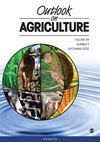巴西一个重要生产中心的豆类作物的空间和经济动态
IF 2.6
3区 经济学
Q1 AGRICULTURE, MULTIDISCIPLINARY
引用次数: 0
摘要
豆类是人类食用的传统粮食作物,对巴西的粮食安全和农民收入具有重要意义。巴拉那州是巴西最大的豆类生产州之一,但其生产所需的面积正在减少,改变了豆类种植的动态,并产生了社会和经济影响。本研究的目的是核实巴拉那州豆类生产的时空和经济动态。为此,主要利用 2006 年和 2017 年农业普查的数据,应用了区位商数、赫希曼-赫芬达尔指数(HHI)、威廉姆森系数([公式:见正文])、探索性空间数据分析(ESDA)和主成分分析(PCA)。结果表明,豆类生产专业市镇的数量从 2006 年的 98 个减少到 2017 年的 86 个,减少了 13.95%。大多数专业市镇生产黑豆或其他彩色豆类的组合。HHI 显示,专业市镇从豆类生产中获得的收入最多。公式:见正文]表明,巴拉那中东部和东南部中间区域的经济发展与豆类生产有关。根据 ESDA,发现 2006 年(Moran' I = 0.36)和 2017 年(Moran' I = 0.51)的空间集聚具有显著的统计意义和积极意义。根据 PCA,可以确定两个主要成分,它们共同解释了 71.52%的数据变异性。种植面积的减少、专业市镇数量的减少以及豆类生产收入集中在某些市镇,使得巴拉那州的地区差距难以缩小,此外,这些因素还增加了人们对粮食安全的担忧;因此,需要制定公共政策来减少这些影响。本文章由计算机程序翻译,如有差异,请以英文原文为准。
Spatial and economic dynamics of bean crops in an important production hub in Brazil
Beans are a traditional grain crop consumed by humans that is of great importance for food security and farmers in terms of income in Brazil. Paraná is one of the largest bean-producing states in the country, but the area needed for its production is being lost, changing the dynamics of bean cultivation, and generating social and economic impacts. The objective of this study was to verify the spatiotemporal and economic dynamics of bean production in Paraná. For this purpose, using mainly data from the 2006 and 2017 agricultural censuses, the location quotient, the Hirschman–Herfindahl Index (HHI), the Williamson coefficient ([Formula: see text]), exploratory spatial data analysis (ESDA), and principal component analysis (PCA) were applied. From the results, it was possible to verify that there was a 13.95% reduction in the number of municipalities that specialized in bean production, from 98 municipalities in 2006 to 86 in 2017. Most specialized municipalities produced black beans or a combination of other colored beans. The HHI revealed that the specialized municipalities accounted for the most income from bean production. The [Formula: see text] indicated that the economic development of the central-eastern and southeastern Paraná mesoregions was related to bean production. Based on the ESDA, it was found a statistically significant and positive presence of spatial concentration in 2006 (Moran’ I = 0.36) and 2017 (Moran’ I = 0.51). Based on the PCA, it was possible to identify two main components that together explained 71.52% of the data variability. The reduction in the planted area, the decrease in the number of specialized municipalities, and the concentration of income from bean production in some municipalities make it difficult to reduce regional disparities in Paraná, and in addition, these factors increase concern about food security; thus, public policies are needed to reduce such impacts.
求助全文
通过发布文献求助,成功后即可免费获取论文全文。
去求助
来源期刊

Outlook on Agriculture
农林科学-农业综合
CiteScore
5.60
自引率
13.30%
发文量
38
审稿时长
>36 weeks
期刊介绍:
Outlook on Agriculture is a peer reviewed journal, published quarterly, which welcomes original research papers, research notes, invited reviews and commentary for an international and interdisciplinary readership. Special attention is paid to agricultural policy, international trade in the agricultural sector, strategic developments in food production, the links between agricultural systems and food security, the role of agriculture in social and economic development, agriculture in developing countries and environmental issues, including natural resources for agriculture and climate impacts.
 求助内容:
求助内容: 应助结果提醒方式:
应助结果提醒方式:


